
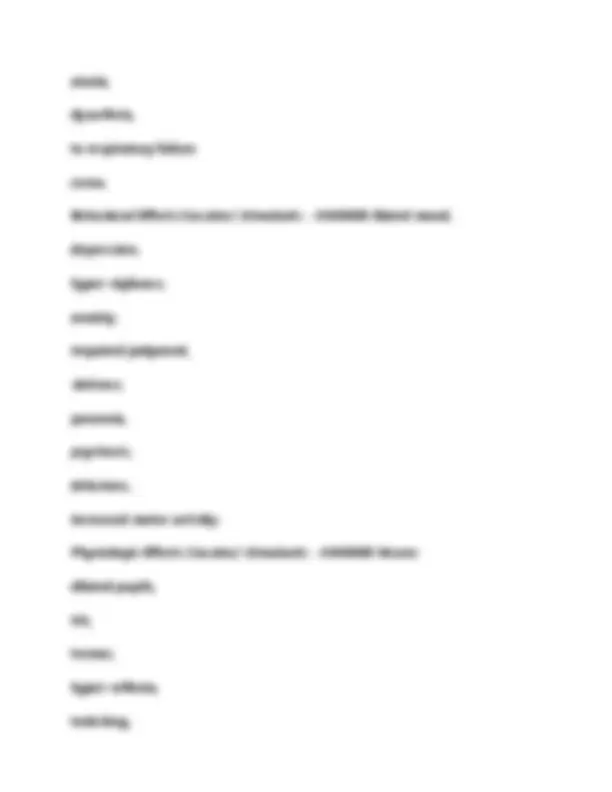
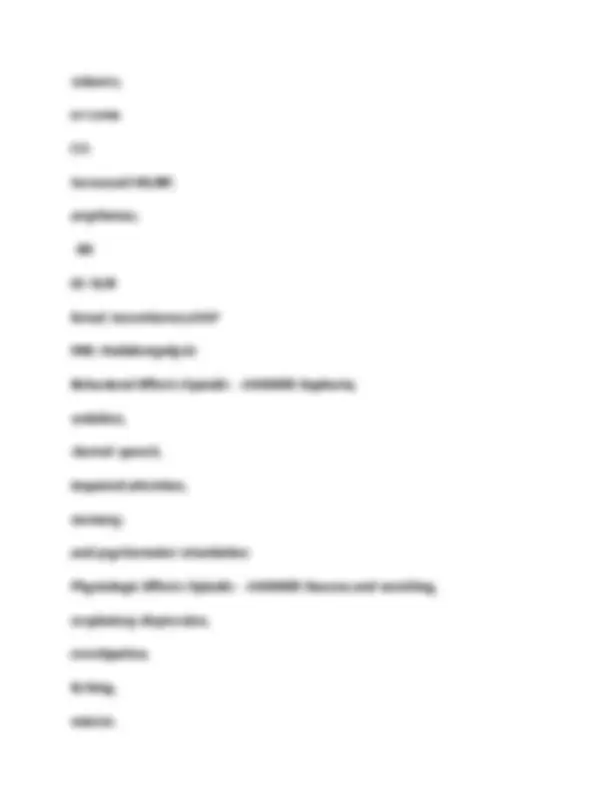
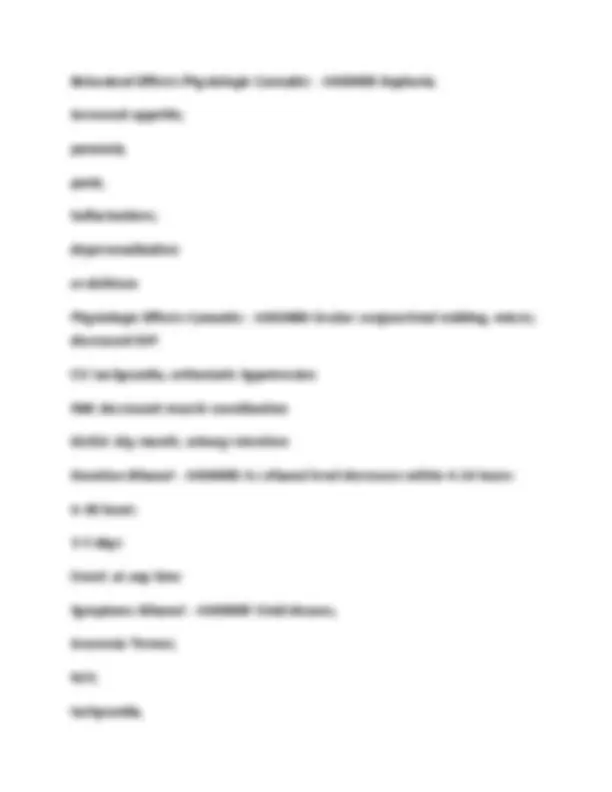
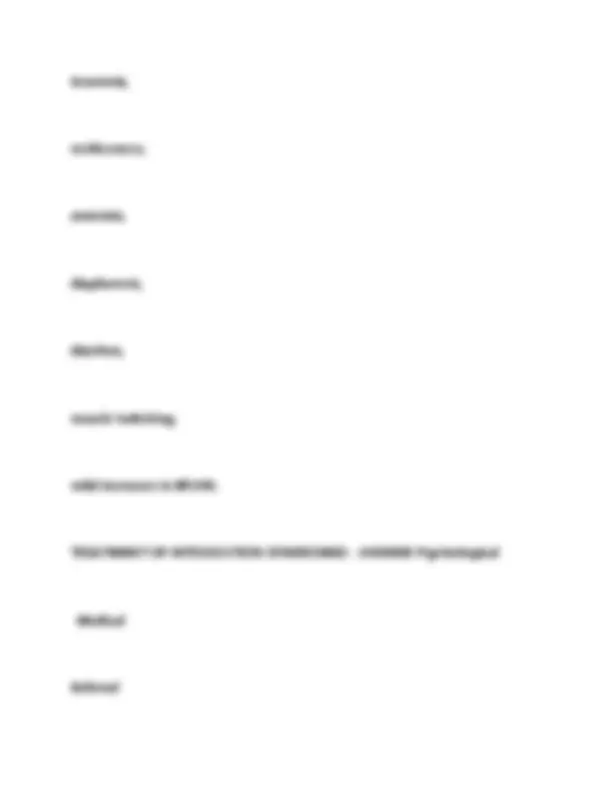
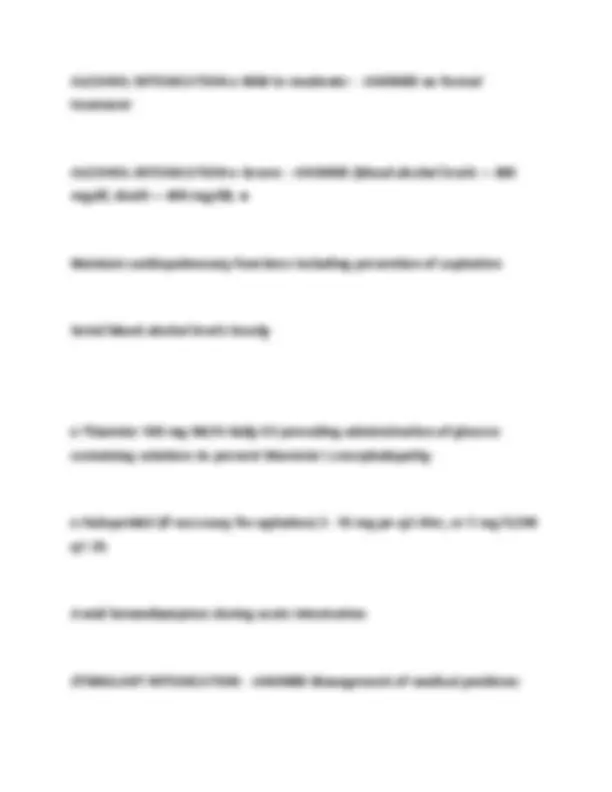
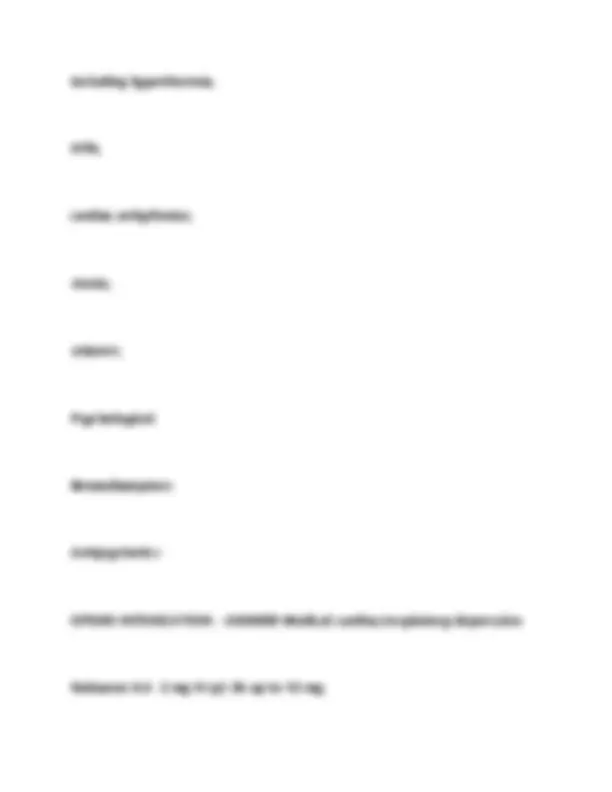
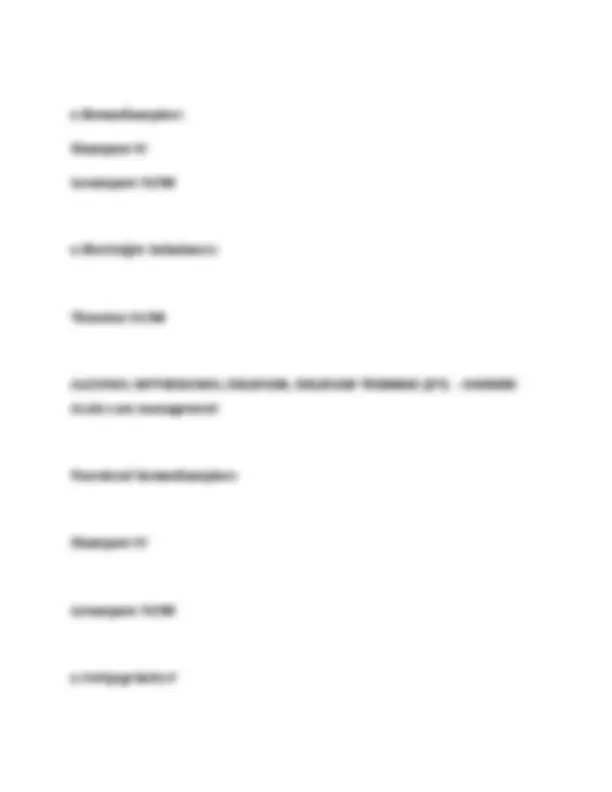
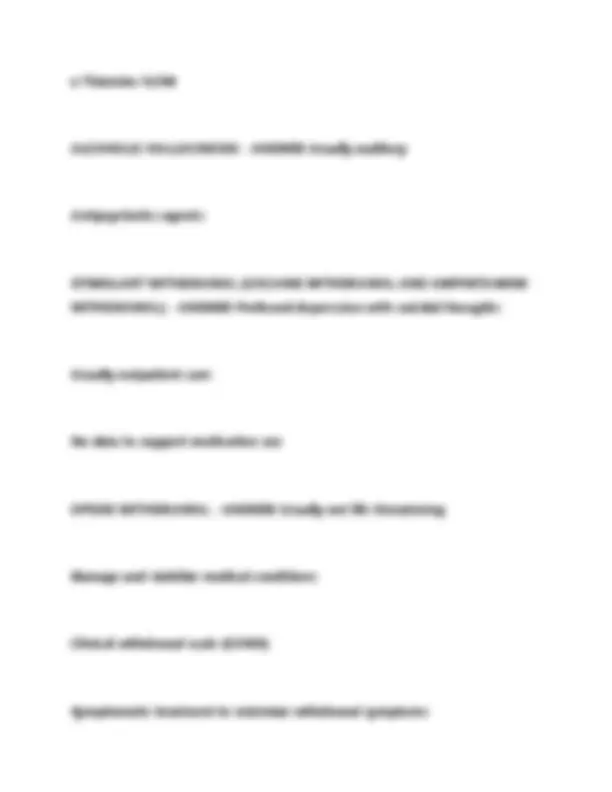
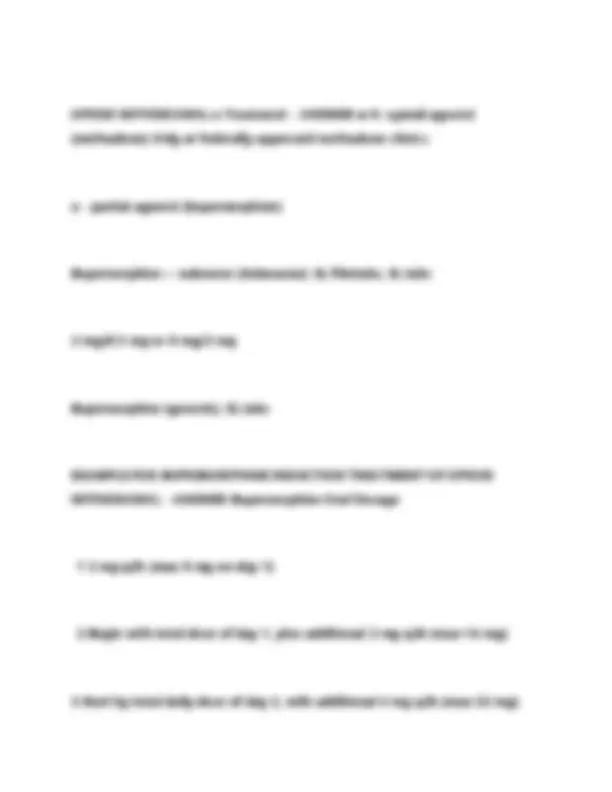
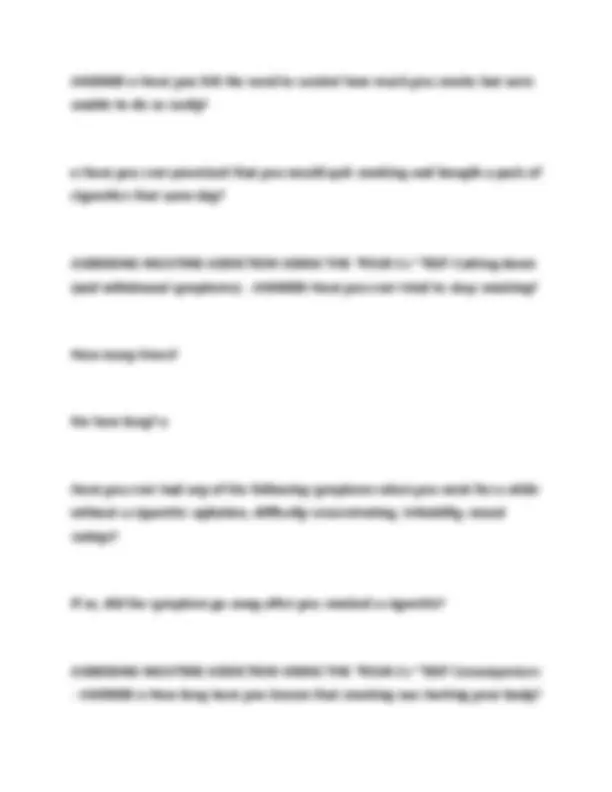
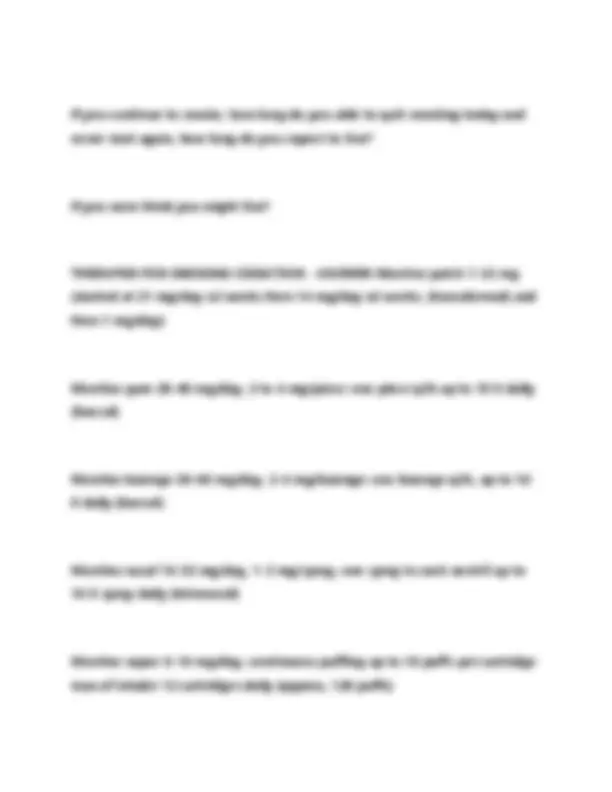
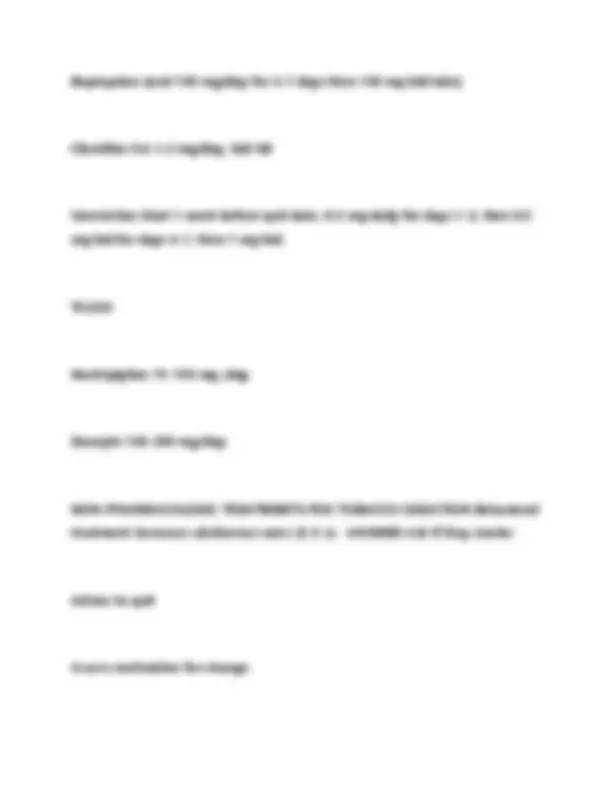
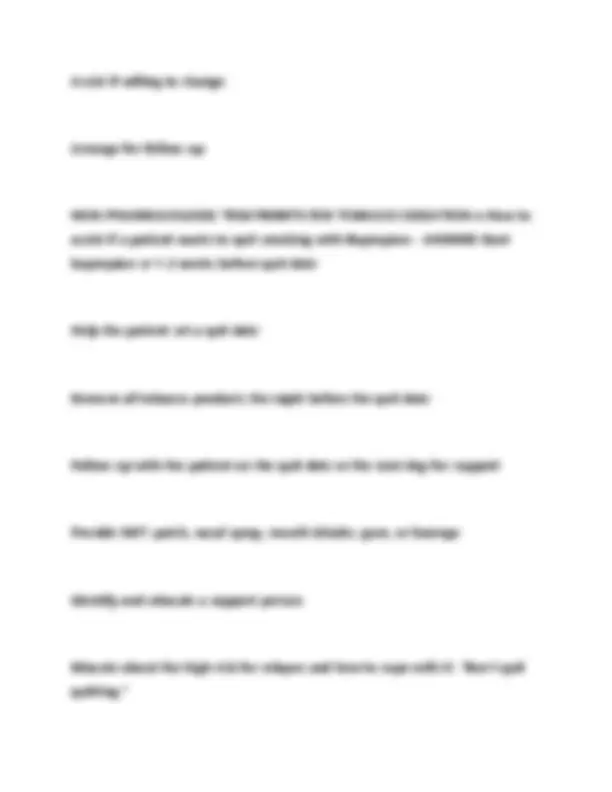
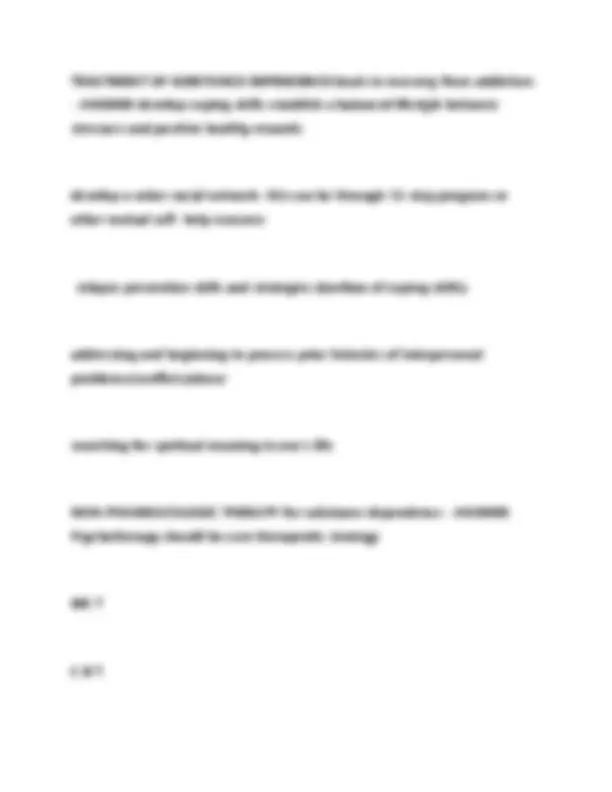
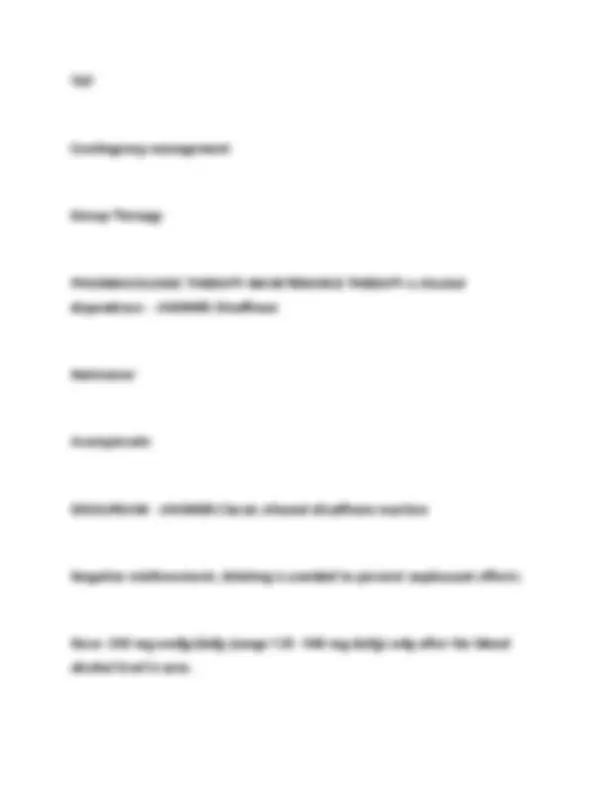
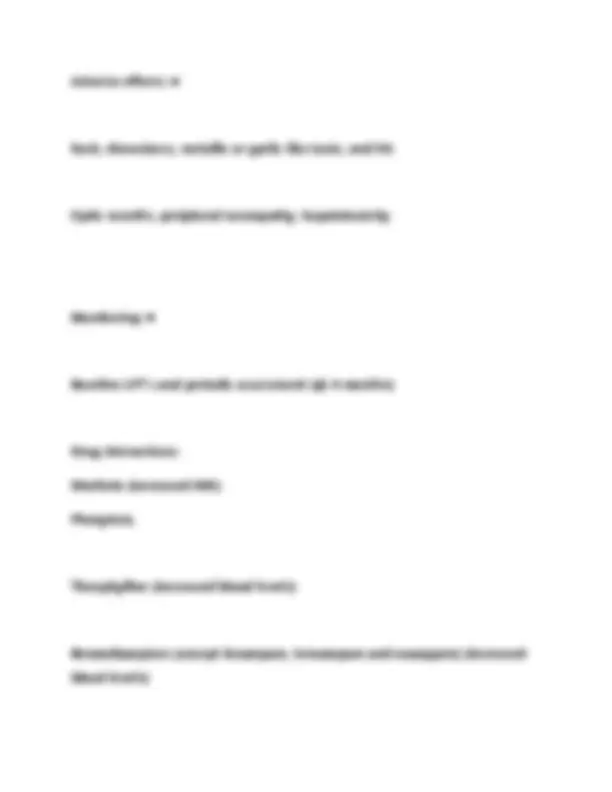
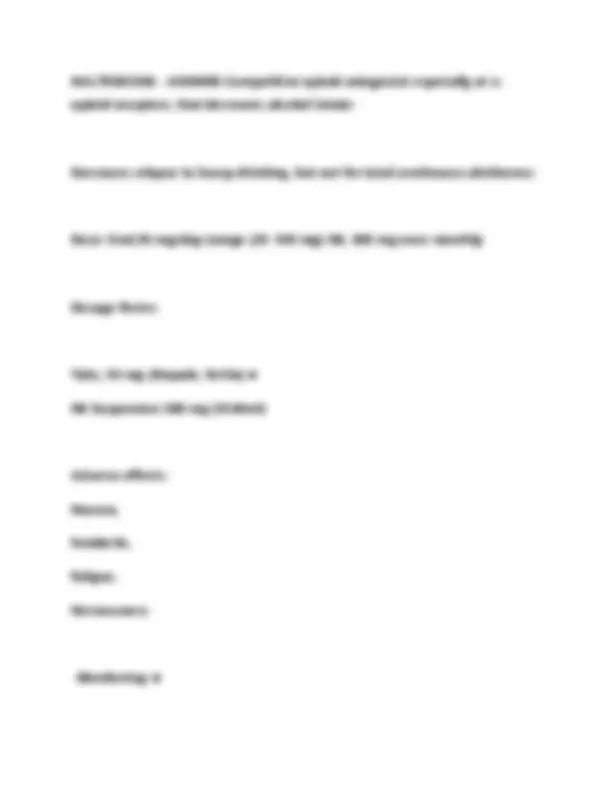
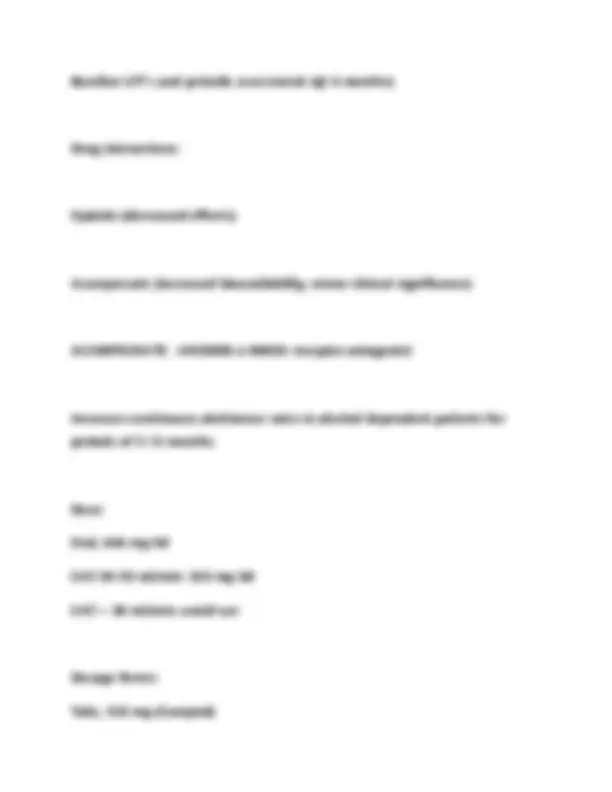
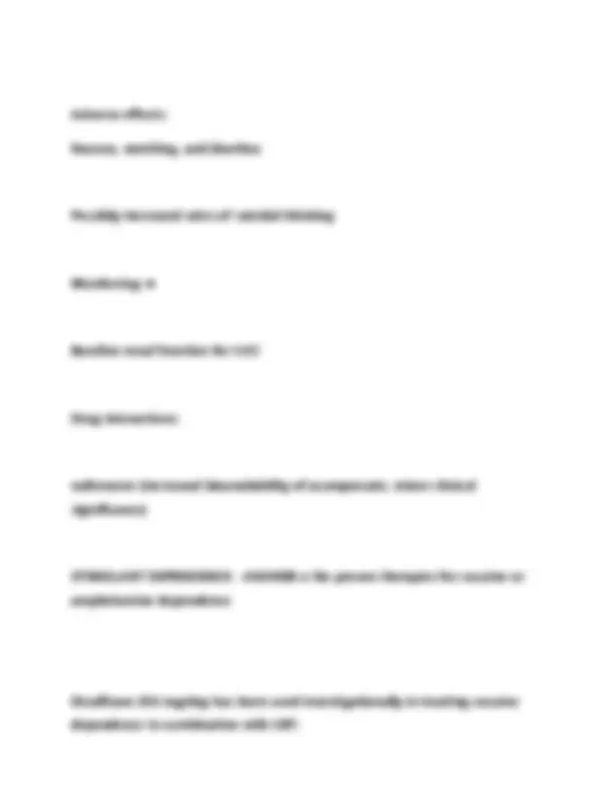
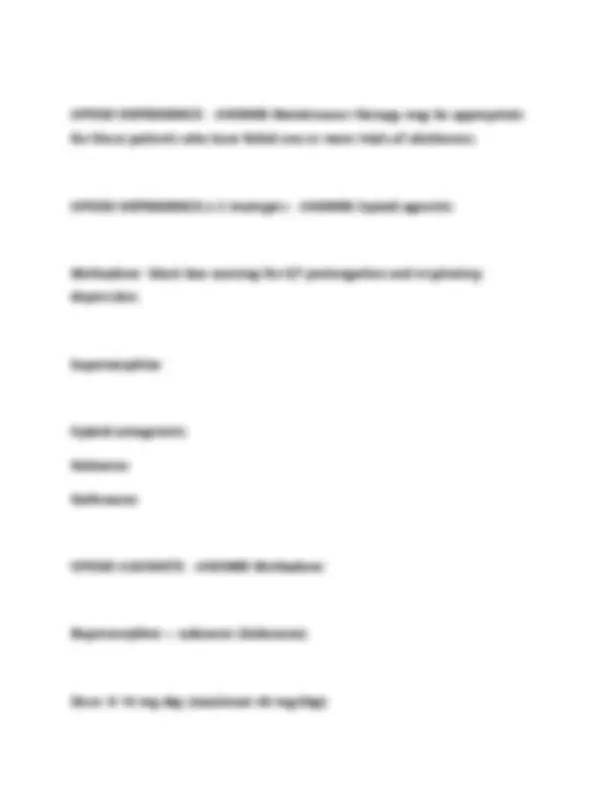
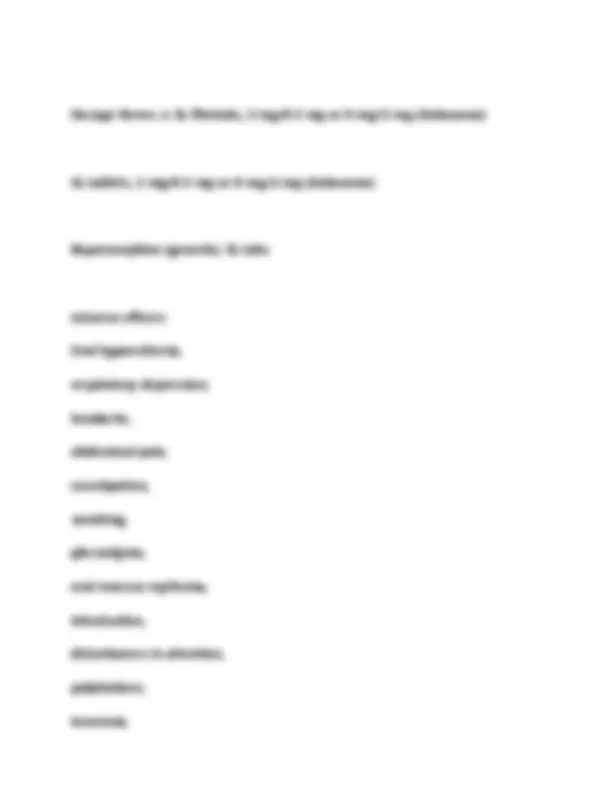
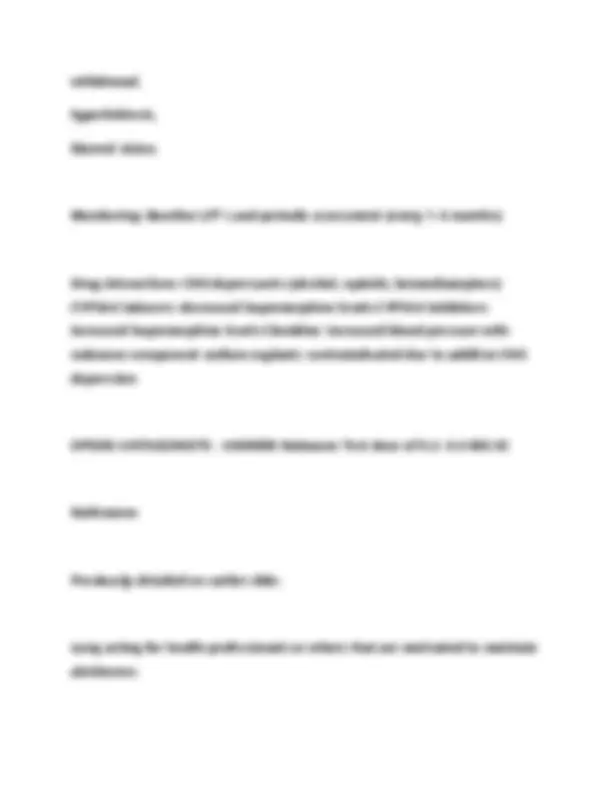


Study with the several resources on Docsity

Earn points by helping other students or get them with a premium plan


Prepare for your exams
Study with the several resources on Docsity

Earn points to download
Earn points by helping other students or get them with a premium plan
Community
Ask the community for help and clear up your study doubts
Discover the best universities in your country according to Docsity users
Free resources
Download our free guides on studying techniques, anxiety management strategies, and thesis advice from Docsity tutors
This document offers a thorough overview of substance-related disorders, covering key aspects such as reward pathways, pathophysiology, clinical presentation, diagnosis, and treatment of intoxication and withdrawal syndromes. it delves into specific substances like alcohol, stimulants, opioids, nicotine, and cannabis, detailing their effects and treatment approaches. The document also includes assessment tools like the ciwa-ar and cage questionnaire, enhancing its practical value for students.
Typology: Exams
1 / 30

This page cannot be seen from the preview
Don't miss anything!























Reward pathway - ANSWER Genetic, environmental, cultural factors interact Primary NT is dopamine Key areas: dopamine mesocorticolimbic system, ventral tegmental area (VTA), nucleus accumbens (NA), the amygdala, olfactory tubercle. Cocaine and stimulants, such as amphetamines - ANSWER activate the reward system by blocking dopamine reuptake transporter. Opioids - ANSWER activate the same circuitry as the stimulants (initially they activate opioid receptors in the VTA, which ultimately results in an increase in dopamine release in the NA) Ethanol - ANSWER produces its effects by multiple pathways (antagonism of modulation of GABA receptors, activate dopamine indirectly by facilitating activity of GABA neurons in the par reticulata, ultimately disinhibiting the VTA dopamine neurons resulting in increase dopamine in the NA.
Nicotine - ANSWER acts on the opioid pathway Marijuana (active component tetrahydrocannabinol, THC) - ANSWER binds to cannabinoid-1 (CB) receptors resulting in activation of dopamine neurons in the mesocorticolimbic system. THC also increases the release dopamine into the shell of the NA. PATHOPHYSIOLOGY Neuronal Adaptation - ANSWER Chronic use of abused substances resulting in both addiction and withdrawal may be related to neuroadaptive effects occurring within the brain. Sensitization Counter adaptation GOALS OF THERAPY - ANSWER o Alleviate the effects of drug intoxication o Attenuate the adverse effects of withdrawal o Decrease craving for, and relapse to, abused substances CLINICAL PRESENTATION AND DIAGNOSIS - ANSWER o Chronic pattern of use of abused substances meet DSM-5 criteria o Pattern of substance abuse that has resulted in undesirable social, occupational, and legal consequences Behavioral Effects Ethanol - ANSWER Labile mood, aggressive or sexual behavior, giddiness or verbally loud, impaired judgment, somnolence and coma. Physiologic Effects Ethanol - ANSWER Variable with blood levels from decreased reaction time, muscle incoordination,
seizures, or coma CV: Increased HR/BP, arrythmias, MI GI: N/B Renal: incontinence/ARF NM: rhabdomyolysis Behavioral Effects Opioids - ANSWER Euphoria, sedation, slurred speech, impaired attention, memory, and psychomotor retardation Physiologic Effects Opioids - ANSWER Nausea and vomiting, respiratory depression, constipation, itching, mioisis.
Behavioral Effects Physiologic Cannabis - ANSWER Euphoria, increased appetite, paranoia, panic, hallucinations, depersonalization or delirium Physiologic Effects Cannabis - ANSWER Ocular: conjunctivial redding, miosis, decreased IOP. CV: tachycardia, orthostatic hypotension NM: decreased muscle coordination GI/GU: dry mouth, urinary retention Duration Ethanol - ANSWER As ethanol level decreases within 6-24 hours 6-48 hours 3-5 days Onset: at any time Symptoms Ethanol - ANSWER Vivid dreams, insomnia Tremor, N/V, tachycardia,
duration >1 week. Symptoms Opioids - ANSWER GI: N/V/D and dehydration Neuro irritability, restlessness, yawning, and twitching. CV: Increase HR/BP MS: chills, increased temperature, rhinorrhea Ocular: lacrimation, dilated pupils. Duration Nicotine - ANSWER Within 24 hours of cessation WITHDRAWAL Symptoms Nicotine - ANSWER Varies with degree/duration of nicotine use: anxiety, irritability, frustration, anger, craving, decreased concentration, decreased HR, and increased appetite.
WITHDRAWAL Symptoms Cannabis - ANSWER Withdrawal usually not noticeable except in chronic heavy use,
withdrawal occurs in 24 hrs,
peaks in 2-4 days,
and resolves in 1-2 weeks.
WITHDRAWAL Symptoms Cannabis - ANSWER Irritability,
insomnia,
restlessness,
anorexia,
diaphoresis,
diarrhea,
muscle twitching,
mild increases in BP/HR.
TREATMENT OF INTOXICATION SYNDROMES - ANSWER Psychological
Medical
Referral
including hyperthermia,
HTN,
cardiac arrhythmias,
stroke,
seizures.
Psychological:
Benzodiazepines
Antipsychotics
OPIOID INTOXICATION - ANSWER Medical: cardiac/respiratory depression
Naloxone 0.4- 2 mg IV q2-3h up to 10 mg.
TREATMENT OF WITHDRAWAL SYNDROMES o Goals - ANSWER Evaluation of withdrawal symptoms and whether pharmacologic intervention is necessary
Management of medical consequences.
Referral for substance abuse program
ALCOHOL WITHDRAWAL 4 different alcohol withdrawal syndromes: - ANSWER 1. Uncomplicated alcohol withdrawal
2 Alcohol withdrawal seizures
UNCOMPLICATED ALCOHOL WITHDRAWAL - ANSWER o Most common
Symptoms typically rated using a validated scale such as the Clinical Institute Withdrawal Assessment Scale for Alcohol- Revised (CIWA-Ar)
o Benzodiazepines Diazepam IV Lorazepam IV/IM
o Electrolyte imbalances
Thiamine IV/IM
ALCOHOL WITHDRAWAL DELIRIUM, DELIRIUM TREMENS (DT) - ANSWER Acute care management
Parenteral benzodiazepines
Diazepam IV
Lorazepam IV/IM
o Antipsychotics?
o Thiamine IV/IM
ALCOHOLIC HALLUCINOSIS - ANSWER Usually auditory
Antipsychotics agents
STIMULANT WITHDRAWAL (COCAINE WITHDRAWAL AND AMPHETAMINE WITHDRAWAL) - ANSWER Profound depression with suicidal thoughts
Usually outpatient care
No data to support medication use
OPIOID WITHDRAWAL - ANSWER Usually not life threatening
Manage and stabilize medical conditions
Clinical withdrawal scale (COWS)
Symptomatic treatment to minimize withdrawal symptoms
4-5 Maintain on dose required to alleviate withdrawal symptoms
6+ Decrease dose by 25 % each day (or less if patient does not tolerate 25 %)
NICOTINE WITHDRAWAL - ANSWER o Standard of care to provide smokers with advice and assistance to quit, or referral to specialized services.
o Several neurotransmitters are affected
o CAGE, 4 C's, and the Fagerstrom test for nicotine dependence
o All nicotine replacement therapies are regulated by FDA.
CAGE QUESTIONNAIRE FOR NICOTINE DEPENDENCE - ANSWER 1. Have you ever felt a need to Cut down or control your smoking, but had difficulty doing so?
Two "yes" responses constitute a positive screening test.
Information from Lairson DR, Harrist R, Martin DW, Ramby R, Rustin TA, Swint JM, et al. Screening for patients with alcohol problems: severity of patients identified by the CAGE. J Drug Educ 1992:22:337-52.
ASSESSING NICOTINE ADDICTION USING THE "FOUR Cs" TEST Compulsion - ANSWER o Do you ever smoke more that you intend?
o Have you ever neglected a responsibility because you were smoking, or so you could smoke?
ASSESSING NICOTINE ADDICTION USING THE "FOUR Cs" TEST you Control -
If you continue to smoke, how long do you able to quit smoking today and never start again, how long do you expect to live?
If you were think you might live?
THERAPIES FOR SMOKING CESSATION - ANSWER Nicotine patch 7-22 mg (started at 21 mg/day x2 weeks then 14 mg/day x2 weeks, (transdermal) and then 7 mg/day)
Nicotine gum 20-40 mg/day, 2 to 4 mg/piece: one piece q2h up to 10 X daily (buccal)
Nicotine lozenge 20-40 mg/day, 2-4 mg/lozenge; one lozenge q2h, up to 10 X daily (buccal)
Nicotine nasal 16-32 mg/day, 1-2 mg/spray, one spray in each nostril up to 16 X spray daily (intranasal)
Nicotine vapor 6-16 mg/day, continuous puffing up to 10 puffs per cartridge max of inhaler 12 cartridges daily (approx, 120 puffs)
Buproprion (oral 150 mg/day for 3-7 days then 150 mg bid tabs)
Clonidine 0.6-1.2 mg/day, bid-tid
Varenicline Start 1 week before quit date, 0.5 mg daily for days 1-3, then 0. mg bid for days 4-7, then 1 mg bid.
TCADS
Nortriptyline 75-150 mg /day
Doxepin 150-250 mg/day
NON-PHARMACOLOGIC TREATMENTS FOR TOBACCO CESSATION Behavioral treatment increases abstinence rates (5 A's) - ANSWER Ask if they smoke
Advise to quit
Assess motivation for change